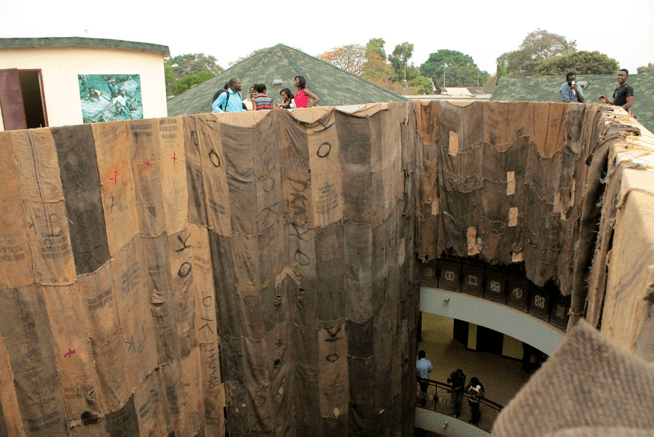Ibrahim Mahama: Trading in Art

Untitled, 2014
Stitched jute coal sacks
Famous for creating installations using Jute sacks, Ibrahim Mahama is an artist working with re-appropriated material purchased from markets in Ghana, where he currently lives and works. Architecture, and the dissonance between its history, form and function is paramount to this artist.[1] Taking materials, which were first cocoa sacks and coal sacks, he has repurposed them to create site-specific installations. As totalizing artworks, they transform various contexts to reveal new spatial realities. Adrastus Collection’s most recent acquisition is a section of these jute coal sack installation that has been attached to a wooden stretcher, mounted in the manner of a painting.
Ibrahim Mahama has discussed the context surrounding artworks and the influence that art history has had on his work, “Studying in art school, we learned about the complex history of painting, exploring how images are constructed and how spaces can be perceived differently. If you can apply paint on a canvas, why can’t you work with an already existing object that has paint applied on it? I use my training as a painter in exploring materials that have a significant history and memory – sometimes at the stage of neglect – which is very relevant to production systems, especially within modern-day history.”[2] The expectation of the art world is rapidly changing and Mahama’s intention is to break away from traditional art practice that he had been taught to do within art school. In his own words, “We need to propose new forms and also constantly expand the sensibilities of both art and the world at large.”[3]

Collaborators at ”Sekondi Loco shed” for intervention series, Sekondi Takoradi, Ghana
Ibrahim Mahama is an artist for whom the collectivist potentialities of art production, recall the progressivism of political action whilst placing the role of commodities at the focal point of his work.[4] He investigates the conditions of supply and demand in African markets, emphasized by the torn, patched sacks, stamped with PRODUCT OF GHANA. The marred bags are transformed as his artistic vision to reuse a commonplace material, repurposing them and then exhibiting them in locations such as the very marketplaces from which they came from. These installations are displayed in Ghanaian markets, as well as Biennales and art fairs around the world, such as the Venice Biennale (2015) and Documenta in Kassel, Germany (2017). Mahama’s specific engagement with the conditions of Ghanaian trade, has led his intensive dialogue into some of the most prestigious art conversations of this generation. Thus defying the traditional teaching and art’s intrinsic value as Mahama uses the coal sacks as a device to explore process, material, value, and meaning within the artistic system.

Left: Ibrahim Mahama – Out of Bounds, 2016, Documenta in Kassel, Germany.
Right: Ibrahim Mahama – Out of Bounds, 2015, Venice Biennale, Italy
Cloth has a symbolic value in Mahama’s practice because of the individual stories and economic dynamics it embodies, in this case the Ghanaian trade.[5] The dirtiness and noticeable worn effect of the canvas is contrasted with the whiteness of the wooden frame behind, appearing to be pristine and only marked with the artist’s signature. The number ‘LXVI’ on the reverse of the artwork, next to the artist signature, is part of the 294 artworks that were produced with he materials used in Kawokudi, Coal Sack Installation, Accra, Ghana.[6]The artist’s assembled his work on stretcher in Untitled (2014), perhaps suggesting both the hiding and highlighting nature of modernist structures in the contemporary art world.

Ibrahim Mahama, Kawokudi, Coal Sack Installation, Accra, Ghana
Ibrahim Mahama lives and works in Accra, Kumasi, and Tamale, Ghana. His solo shows have included: 2018 Kunst & Kohle: Coal Market, Schloss Strünkede, Emschertal-Museum Herne, Stadtische Galerie, Germany; A straight line through the Carcass of History, 1918-1945, daadgalerie, Berlin; Dal-Baħar Madwarha: A straight line through the Carcass of History, Pixkerija, Valletta, Malta; In Dependence, Apalazzo Gallery, Brescia, Italy; On Monumental Silences, Extra City Kunsthal, Antwerp, Belgium; 2017 Non-Orientable Nkansa, Miami Design District, Miami; Inside the White Cube: Fragments, White Cube Bermondsey, London; 2016 Fracture, Tel Aviv Museum of Art, Tel Aviv; Food Distribution Corporation, Artist’s Rooms at K21 Ständehaus, Dusseldorf, Germany. His group exhibition include: 2018 Non-Orientable Nkansa, Art Basel Unlimited, Basel, Switzerland; No Time For Caution 1966, 2014-2018, La Biennale de l’Art africain contemporain: DAK’ART, Dakar, Senegal; Pulling at Threads: the Woven Object in Contemporary, The Norval Foundation Art Gallery, Cape Town; EX AFRICA, Centro Cultural Banco de Brasil, São Paulo; Centro Cultural Banco de Brasil, Rio de Janeiro; Triângulo do Atlântico, 11a Bienal de Artes Visuais do Mercosul, Porto Alegre, Brazil; 2017 Manipulate the World, Moderna Museet, Stockholm; EX AFRICA, Centro Cultural Banco de Brasil, Belo Horizonte, Brazil; Documenta 14, Kassel, Germany; Future Generation Art Prize at Venice, Palazzo Contarini Polignac, Event of the 57th Venice Biennale, Venice (Future Generation Art Prize touring exhibition); Documenta 14, Athens; Future Generation Art Prize, PinchukArtCentre, Kiev, Ukraine; When the Heavens Meet the Earth, Selected Works from the Robert Devereux Sina Jina Collection of Contemporary Art, The Heong Gallery at Downing College, Cambridge, UK.
[1] “On Failure, Decay, and New Forms of Responsibility. A Conversation with Ibrahim Mahama:” Flash Art, 22 May 2019, flash—art.com/2019/05/ibrahim-mahama/.
[2] Obuobi, Sharon, Conversation with Ibrahim Mahama, Journal of Contemporary African Art. p.42-43. November 2018
[3] “On Failure, Decay, and New Forms of Responsibility. A Conversation with Ibrahim Mahama:” Flash Art, 22 May 2019, flash—art.com/2019/05/ibrahim-mahama/.
[4] Mousse Magazine, moussemagazine.it/ibrahim-mahama_civilocchttp://moussemagazine.it/ibrahim-mahama_civiloccupation_ellisking_dublin2014/upation_ellisking_dublin2014/.
[5] “’In Dependence’: Ibrahim Mahama’s Monuments to the Anonymous.” Frieze, 2 Mar. 2018, frieze.com/article/dependence-ibrahim-mahamas-monuments-anonymous.
[6] Karenarchey. “How Simchowitz Turned Jute into $4.45 M, and Might Lose It All.” e, 26 Aug. 2015, conversations.e-flux.com/t/how-simchowitz-turned-jute-into-4-45-m-and-might-lose-it-all/2334.
